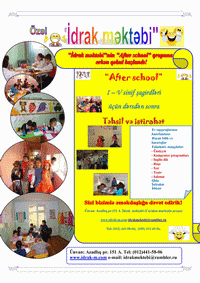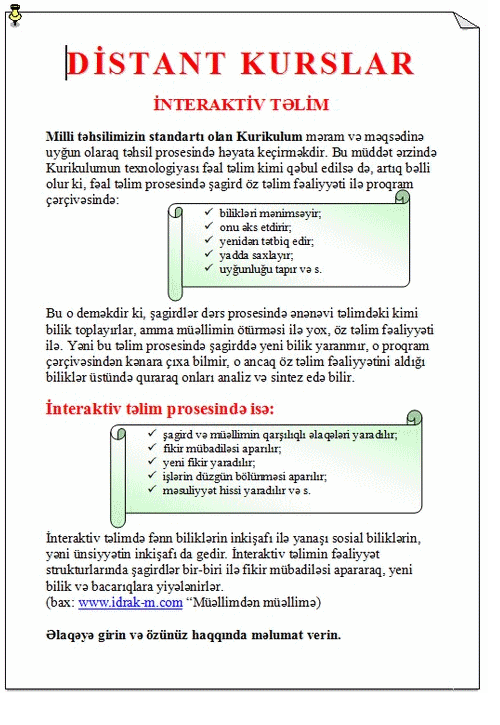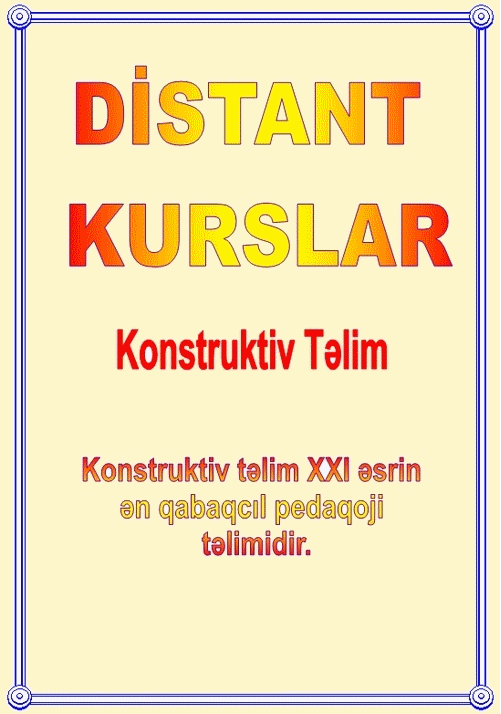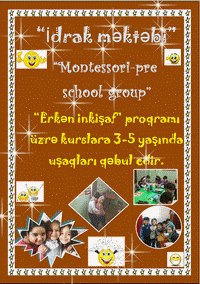Simulation Learning Based On Formal-Logical and Fuzzy Logics
Fatma Khanim Bunyatova ( fatmaxanum@rambler.ru )
Intellect School, Baku, Azerbaijan
Gulbala Salamov ( gulbala.salamov@metu.edu.tr ) Department of Computer Education & Instructional Technology, METU, Ankara, Turkey
Bu məqalə Yaponiyada və Türkiyədə kecirilən Beynəlxalq konfranslarda təqdim edilmişdi. Məqaləyə beynəlxalq səviyyədə olan maraq bu məqalənin ingilis variantında sayta yerləşdirməyə qərara gəldik. Tezliklə bu məqalənin Azərbaycan və rus variantını dəyərli oxucularımıza catdıracağıq.
Abstract:
Computerization of schools and the introduction of ICT into the education process increased the possibilities of the school. These possibilities of ICT in essence have not changed the traditional role of teacher and student. The teacher, taking advantage of these technologies expands the knowledge transferred, with an emphasis on visual memory, the preservation of knowledge in memory, but not on cognition of that knowledge .To reach the desired level of time, students need to spend the next change in the learning process. Change the way of learning, from the position of the transfer of knowledge to pass on the position of constructive learning. Construct knowledge logically. Construct the model structures of the knowledge content. Model of knowledge is built on logic integrity of Piaget and fuzzy logic of Zadeh. Consequently, these 3 principles are changing form of learning. Instead of obtaining knowledge conditions are created for their design based on existing knowledge.
Key words: higher level, cognition, formal-logical, fuzzy logic , construct knowledge, Simulation, modeling, substitution;
Demands Of Society From Today’s School
Computerization of schools and the introduction of ICT into education process increased the possibilities of the school. But despite the transfer of computer technology and ICT in learning they can not transform education to higher level. They are only technical means by which only technical capabilities of lesson are extend.
The possibilities of ICT in essence have not changed the traditional role of teacher student. The teacher, taking advantage of these technologies expands the knowledge in memory, but not on cognition of the knowledge.
Lack of cognitive activity of students leads to a uniform, easily controlled thinking. Students who formed such a type of thinking that can grow only in the good performers. But the fast-changing technological society requires that the school has produced mobile, creative-minded students who possess not only computer technology but also possess the skills of self -development and self-knowledge. They should not have good knowledge only, but they should be able to easily convert and apply it to the new conditions.
Despite the rapid modification of the technological devises effectively expectation of society is not executed. The reason is that, technical equipment of the educational principles of the nested in traditional teaching didactics which exists more than 300 years was focused on memory. Knowledge as a didactic unit was remembered transferring private, unsystematically, constructed on non logical knowledge. But education can change the quality and make it accessible to all, if we activity of students over the knowledge to understand them. The aim of education should be to develop the structures of intelligence, which in turn develops the knowledge structure.
Two leading figure of the 20th century, Piaget and Zadeh built the structure of natural and artificial intelligence.
Model of natural intelligence was built by Piaget. Logic integrity of Piaget’s work, or the mind on an operational level , i.e. formal-logical level, is the work of the human brain [ ]. Zadeh set up SC, which provides for the sharing of new approaches such fuzzy-logic, neural networks evolutionary computation, etc[1999 ] These technologies are essential for compressing data and system design with high MIG and SC is the best model of the human brain, as noted by Zadeh. Both say the same, the structure of intelligence. Piaget describes that construction with psychological concepts and Zadeh with mathematical way.
To reach the desired level of society, students need to spend the following changes in the learning process.
I. Change the way of learning from the position of transfer of knowledge to pass on the position of constructing such a learning process in which each student builds structure of the knowledge based on own competency [2007 ]. It literally means to put the thinking of students to the forefront in the process of learning.
II. Construct knowledge logically. Knowledge structure is to be developed isomorphic to structures of natural intelligence.
III. Construct the model structures of the knowledge content. Modeling of the knowledge structures should take place in two stages:
a) to build holistic logical model structures of the knowledge with the help of Piaget’s logical concepts of the theory of intelligence. This construction must be isomorphic to the structure of intelligence. The obtained integrity-logical or formal-logic model will be a model of knowledge structures and patterns of natural intelligence;
b) psychological concepts in Piaget’s formal-logical models of knowledge are replaced by mathematical concepts of fuzzy logic Zadeh;
c) the resulting formal logic and fuzzy knowledge model will be psycho and technologically constructed model of knowledge learning.
As a result, these 3 principles change the format of learning. Instead of obtaining knowledge conditions are created for their design based on existing knowledge.
How This Can Be Done And What It Means?
1. Change The Way Of Learning.
Change the way learning means a transition from private practices to technology education. In this case, we propose Bunyatova’s constructive learning technology [ 2008]. Technology of constructive learning based on cognitive theories of Piaget’s.[2001] Constructive learning is a creative, activity-an operational training, which provides an opportunity for each student to build their new knowledge based on their own experiences, on their current knowledge. The philosophy of Bunyatova’s constructive learning (CL) is a synthesis of Eastern and Western learning philosophy, and this is shift of private knowledge to the integrity of knowledge, or on the integrity or vice verse on the integrity knowledge to the particular. Constructive learning aimed at changing of learner’s activity mode and the learning process, which eventually leads to a change not only the learning process, but all relevant components.
Constructive Learning by Bunyatova takes its origins from the psychological school of Piaget and Vigotsky, it contains the co-operative structure learning activities of the American psychologist Spenser Kagan.
Constructive Learning Technology aims to develop student’s intelligence structure, to organize their thinking activity over the logical structures of knowledge.
Knowledge, in its turn, can be logically combine, divide, associate, cancel and turn a complicated structure. Mental operations of Piaget logical apparatus are carried out over the knowledge. Logical reasoning and setting transform existing knowledge into qualitatively new learning and create conditions for formation.
2) Logical structuring of knowledge.
Subject knowledge is still presented as a didactic unit of knowledge. They learn from the private and studying for years to come the integrity of knowledge. Instead, it is proposed to build knowledge logically in the integrity scheme. Knowledge structures can be logically combined, divided, associated, canceled, etc.
Knowledge structures should isomorphically develop structures of natural intelligence.
3) Modeling of the structures of knowledge.
Modeling of the structure of knowledge should take place in two stages.
The first stage is the construction of formal logical models of knowledge.
Formally logical model of knowledge based on Piaget’s logic integrity. Knowledge structure in the model is divided into variable and constant. Variable knowledge is a categorical knowledge, constant knowledge is an invariant.
On the example of linguistic knowledge the invariant knowledge is a part of speech, and the variable is a category
language. Invariant structures variables are constructed vertically. These knowledge structures are built isomorphic to the structure of the intellect. The construction means the genetic construction of knowledge and each student depending on their development can define in this their own level. Logically constructed knowledge structures can be associated, united, divided, canceled, etc. All these mobile structures occur through movement of logical operations of the thought as classification, seriation, multiplicative and replacement operations.[ 2001]
The second stage is the substitution of the concepts of formal logical knowledge concepts of fussy logic by Zadeh.
Psychological concepts is formally constructed a logical model of subject knowledge, are replaced by Zadeh’s concepts of fuzzy logic [2008 ]
We get the formal-logically and fuzzy knowledge model, since the essence of the concepts of logic by Zadeh coincides with the essence of the concepts of logic integrity by Piaget. The only difference in languages: Piaget uses concepts of natural intelligence but Zadeh uses concepts of artificial intelligence language.
So the notion of categorical knowledge or variables knowledge by Piaget is replaced by Zadeh’s concept of linguistic variable. Proceeding from the concepts of linguistic variable by Zadeh, the membership functions correspond to two rules:[1976]
I. syntax, which is given in the form of grammar to generate the name of the variable in the form of categories of language;
II. semantic, which determines the algorithmic procedure for computing the meaning of each value.
The concept of invariant knowledge replaced by the term “fuzzy set”
“Fuzzy set” an example of linguistic knowledge is represented as a vocabulary of the language . A linguistic variable linguistic is knowledge represented semantic meanings of words and language categories.
Under the membership function of fuzzy set,[2011]the words will be understood in the lexical meaning.
How is a model of subject knowledge built for learning?
In order to build a model of subject knowledge for learning, the followings need to be done:
1. Divide structures of knowledge into variables, that is into linguistic and variable and invariant variable namely, into a universal set.
2. Invariant knowledge or universal set of knowledge is denoted by X.
3. This knowledge is classified divided into classes or elements of the set and is build on the horizontal. The resulting classes of invariant knowledge or elements of the set are denoted by x 0.1 … x0, 9. Invariant knowledge or the set of knowledge can be finite or infinite according to the classification of the classes themselves.
4. Variable, categorical knowledge or linguistic variable are located vertically and denoted by U. They are also classified and denoted by 0.1; 0.2 and etc [2002].
In work Nordhausen and Langley, [1990] it was noted that formation of categories – is the basis of a unified theory of scientific research. Denoting classes and groups of the set, as well as categorical knowledge of a linguistic variable in number, we can present this knowledge with their properties. Each property takes a serial number. So the sentence “The day was sunny” [chart 1] can be defined on a coordinate plane as points: x0, 1,1 y 0, 1,_ x 0, 5, y, 0 4 _ 1 x0, 2 y01 _ 5. Each element of the set, for example, x0,1 is characterized by its own linguistic variable – y0,. Numerical parameters x0,1,1 by the rules of Russian grammar mean masculine noun, y0, 1 mean a single number, etc. Analogous to these characters, a set of proposals on the basis of available knowledge can be constructed. Each class of knowledge or element of the set is at the same time, a cluster of the structure of knowledge. They have their own rules and laws. Structures of knowledge clusters can be combined, divided, associated and canceled according to logical settings of rules of a linguistic variable. Belonging of the linguistic variable into elements of the set or the logical structures of clusters is determined by logical operations such as operation of substitution, enrichment, identical and multiplicative operations. That is, in this case as the rules of linguistic variable and the rules of elements of the set are in
mobile motion all the time, by combining according to the given settings around the logical structure of knowledge or elements of the set become nanostructures of knowledge
How is a model of subject knowledge built for learning?
In order to build a model of subject knowledge for learning, the followings need to be done:
1. Divide structures of knowledge into variables that is into linguistic variables and invariant variables namely, into a universal set.
2. Invariant knowledge or universal set of knowledge is denoted by X.
3. This knowledge is classified divided into classes or elements of the set and is build on the horizontal. The resulting classes of invariant knowledge or elements of the set are denoted by x 0.1 … x0, 9. Invariant knowledge or the set of knowledge can be finite or infinite according to the classification of the classes themselves.
4. Variable, categorical knowledge or linguistic variable are located vertically and denoted by U. They are also classified and denoted by 0.1; 0.2 and etc [2002].
In work Nordhausen and Langley, [2011] it was noted that formation of categories – is the basis of a unified theory of scientific research. Denoting classes and groups of the set, as well as categorical knowledge of a linguistic variable in number, we can present this knowledge with their properties. Each property takes a serial number. So the sentence “The day was sunny” can be defined on a coordinate plane as points: xa, 1,1 y a, 1, x a, 5, y, a 4 / 1 xa, 2 ya1 / 5. Each element of the set, for example, x0,1 is characterized by its own linguistic variable – y0,. Numerical parameters x0,1,1 by the rules of Russian grammar mean masculine noun, y0, 1 mean a single number, etc. Analogous to these characters, a set of proposals on the basis of available knowledge can be constructed. Each class of knowledge or element of the set is at the same time, a cluster of the structure of knowledge.[2011] They have their own rules and laws. Structures of knowledge clusters can be combined, divided, associated and canceled according to logical settings of rules of a linguistic variable. Belonging of the linguistic variable into elements of the set or the logical structures of clusters is determined by logical operations such as operation of substitution, enrichment, identical and multiplicative operations. That is, in this case as the rules of linguistic variable and the rules of elements of the set are in mobile motion all the time, by combining according to the given settings around the logical structure of knowledge or elements of the set become nanostructures of knowledge
What innovations can bring this thoughtful and technological knowledge model in education?
1. Knowledge is presented in the scheme of integrity. Since language is a means of communication and expression of ideas, then, certainly, the conditions of integrity scheme and logic by Zadeh can be in any scientific knowledge and the rules of logic by Piaget and fuzzy logic can be applied to them.
2. Structures of knowledge are initially divided into invariant and variable or into syntactic and semantic. Numeric designation of categorical and invariant properties of knowledge makes it possible to build coordinates of knowledge on the basis of which the process of independent knowledge constructions will go.
3. Operational ability of thinking enables to collect structures of knowledge into clusters, figure out their interrelationship and attitudes in ‘informational ties’, classify them, enrich, or replace with the other structures. These logical operations gather as a magnet around the structures of knowledge relating to them relevant knowledge and turn them into a nanostructure of knowledge. In its turn, this operational act is a process of creation of an internal neural network of knowledge,
4. Logical operation of thinking allows to collect the knowledge like a magnet around the structure of knowledge and turns in into a nanostructure of knowledge.
5. The logic integrity by Piaget and fuzzy logic by Zadeh break down the traditional vertical construction of structures of knowledge and arrange them into a horizontal structure [1990].
Such a construction of knowledge setting on psychology, education in and high technology, in turn creates nano psych -pedagogical approach to learning[2008].
6. The forma- logical and fuzzy knowledge model using constructive learning can reduce learning time by 20-30%. In applying this model in the learning process student do not depend on the program , since the genetic structuring of knowledge allows everyone in the program of this model their build own individual development program.
The formal-logical and fuzzy model of knowledge can be applied in various forms of computer training. It can be used with a great success to work even with gifted children. Talent requires freedom of variation of the study, the personality of education, regardless of the software foundations.
References
R. Аliyev (1999), Soft Computering, Baku : ANA
F.J. Bunyatova (1990), Logical Way Of Learning. Alternative Education, Baku: Maarif
F.J. Bunyatova(2001) J.Piaje at schoole ‘’Scientific researches’’ Baku
F.J. Bunyatova (2002) Use of fuzzy logic in educational technologie, Baku : Copyright Agency Of The Azerbaijan Republic
F.J.Bunyatova (2007) .The Education Ttechnology. The Constructive Teaching. Retrieved from www.eidos.org
F.J.Bunyatova, Constructive teaching technology and perspectives of Nanopsychopedagogy, International Educational Technology Conference (IETC2009), Ankara, Turkey
A.R.Bunyatova, ‘’Logical Integrity, Fuzzy Logic and Modeling Content of Education’’ AICT-2009, Baku
Lotfi Asker Zadeh (1976), The concept of linguistic variable and its application to the adoption of approximate solutions, Moscow: Mir.
J.Piajete, (2001) The Selected Papers, Moscow
Nordhausen and Langley, Retrieved 2011, from www.filosof.historic.ru/books
V.Pivcin, E.Baculin, D.Corenkov,(n.d) Fuzzy sets control. Retrieved June, 2011, from www.allmath.ru/appliedmath
J.Simens, Downes, Retrieved 2011, from www.letopisi.ru/index.php/







